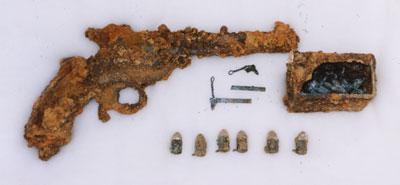Dejima Oranda Shōkan:
Western style pistol and bullets recovered together from the front line of foreign diplomacy in the Edo period

National Land Image(c)Ministry of Land, Infrastructure and Transport, Japan
(Above photo was shot in 1974)
 Remains of the Kapitan’s residence
Remains of the Kapitan’s residence
At the site of the residence of the
director of the Factory (Kapitan) was a two-story building, L-shaped
and with over 28 m of frontage by nearly 12 m deep. As it was the
largest building at Dejima, the foundation stones are well preserved
from its central portion eastward. To the south lay the Dejima Otona
facility for Japanese officials who oversaw trade, and supervised and
gave instructions to Japanese working within Dejima.
 Western style pistol and bullets, and related items
Western style pistol and bullets, and related items
These were recovered
together outside the wall of the Kapitan’s quarters. The pistol
is 31 cm in overall length with a caliber of 1.3 cm, a revolver of
the type invented in the mid 19th century by the Frenchman
Lefaucheux.
The bullets are pinfire cartridges invented by the same person in 1836. Large numbers of friction primers, used when firing canon, had been stored within a square box.
Dejima Oranda Shōkan Remains, Nagasaki City, Nagasaki Prefecture
Takada MiyukiDejima is the name of a man-made island built at the tip of a promontory in Nagasaki in the year Kan’ei 13 (1636), in order to prohibit Christian missionary work on the part of the Portuguese and English. When visits from the Portuguese were banned in 1641, the Dutch Factory was transferred from Hirado to Dejima, which remained the sole point of entry from that time until the opening of Japan in 1859, through which various trade goods, technologies, and aspects of culture were transmitted. In the excavation of the residence of the director of the Factory (Kapitan), the building’s foundation stones and facilities related to water use, such as ditches and a pond used as a reservoir, and rubbish pits were detected. In addition, a variety of materials indicating the way of life of the Factory’s members were recovered, beginning with a western style gun, trade ceramics from Europe, China, and Southeast Asian countries, plus clay pipes, glass objects, animal bones, building materials, etc.

